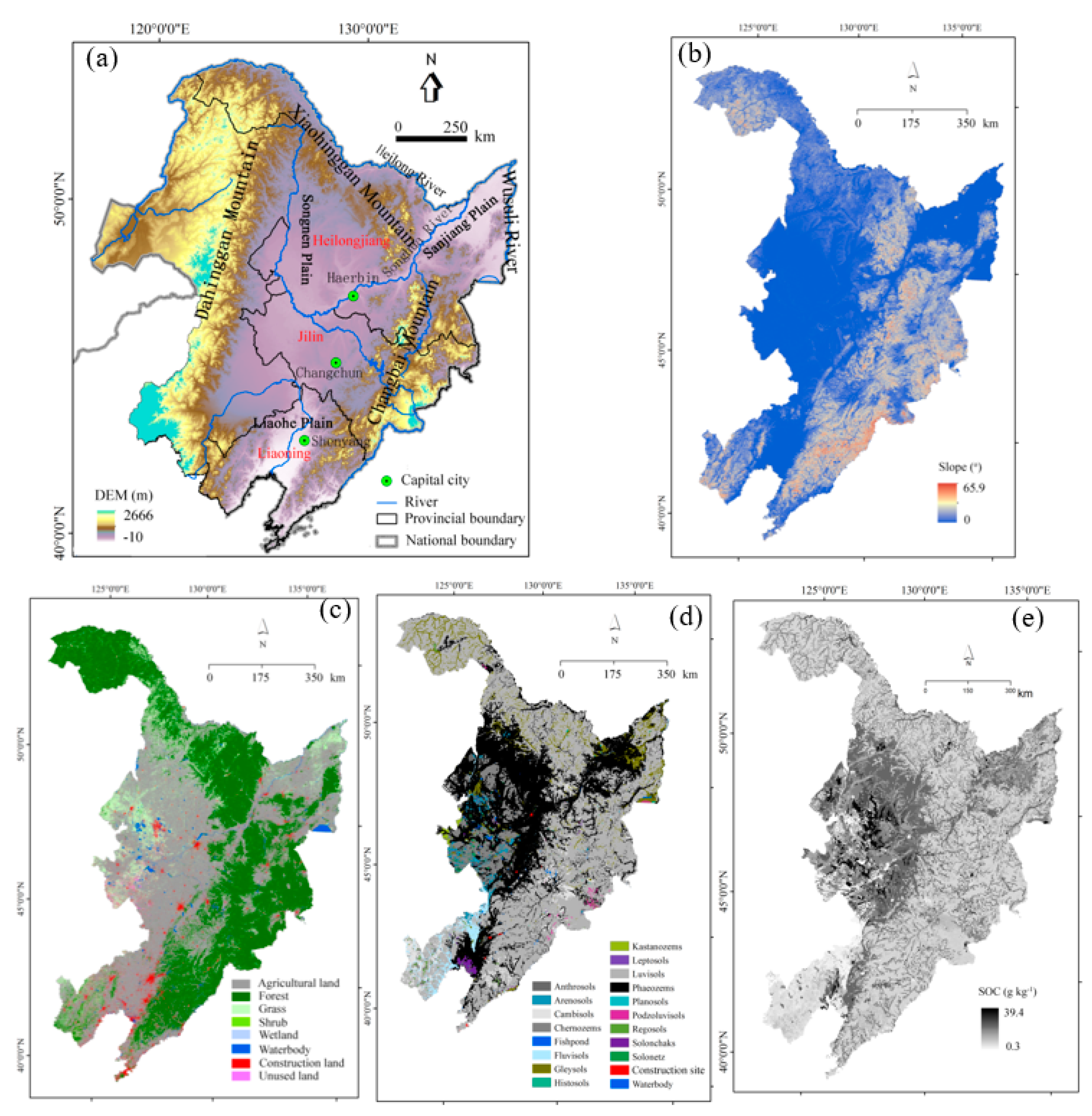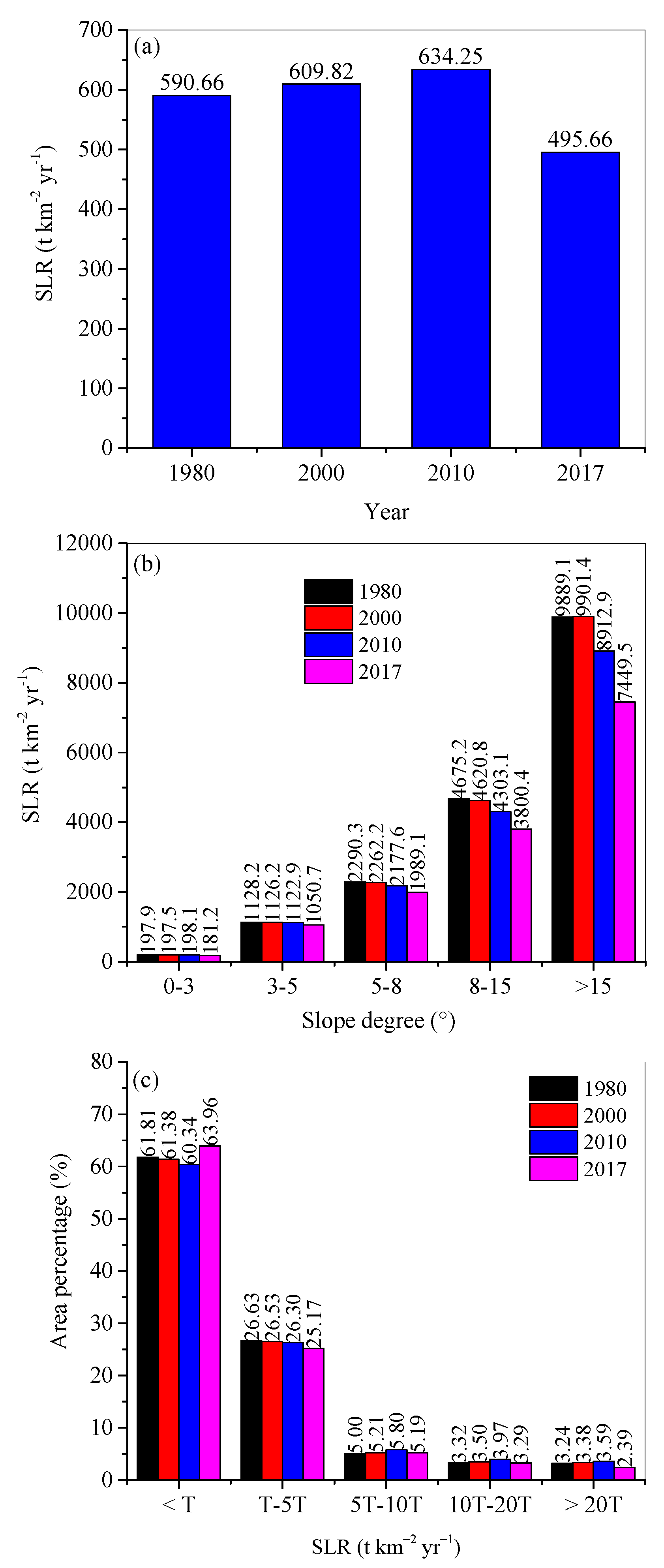Changes in Cultivated Land Area and Associated Soil and SOC Losses in Northeastern China: The Role of Land Use Policies
Abstract
:1. Introduction
2. Materials and Methods
2.1. Study Area
2.2. Data Collection
2.3. Calculations of Soil Erosion and SOC Loss
2.3.1. Water Erosion
2.3.2. SOC Loss
3. Results
3.1. Changes in Cultivated Land Area
3.2. Changes in Soil Erosion
3.3. SOC Loss
4. Discussion
5. Conclusions
Funding
Institutional Review Board Statement
Informed Consent Statement
Data Availability Statement
Acknowledgments
Conflicts of Interest
References
- García-Ruiz, J.M. The effects of land uses on soil erosion in Spain: A review. Catena 2010, 81, 1–11. [Google Scholar] [CrossRef]
- Klein Goldewijk, K.; Beusen, A.; Doelman, J.; Stehfest, E. New anthropogenicland use estimates for the Holocene; HYDE 3.2. Earth Syst. Sci. Data Discuss. 2016, 9, 927–953. [Google Scholar] [CrossRef] [Green Version]
- Foucher, A.; Evrard, O.; Cerdan, O.; Chabert, C.; Lefevre, I.; Vandromme, R.; Salvador-Blanes, S. Deciphering human and climatic controls on soil erosion in intensively cultivated landscapes after 1950 (Loire Valley, France). Anthropocene 2021, 34, 100287. [Google Scholar] [CrossRef]
- Krasilnikov, P.; Makarov, O.; Alyabina, I.; Nachtergaele, F. Assessing soil degradation in northern Eurasia. Geoderma Reg. 2016, 7, 1–10. [Google Scholar] [CrossRef]
- Lal, R. Soil erosion and carbon dynamics. Soil Tillage Res. 2005, 81, 137–142. [Google Scholar] [CrossRef]
- Zhu, Y.L.; Wang, D.Y.; Wang, X.J.; Li, W.B.; Shi, P. Aggregate-associated soil organic carbon dynamics as affected by erosion and deposition along contrasting hillslopes in the Chinese Corn Belt. Catena 2021, 199, 105106. [Google Scholar] [CrossRef]
- Ma, W.M.; Li, Z.W.; Ding, K.Y.; Huang, B.; Nie, X.D.; Lu, Y.M.; Xiao, H.B. Soil erosion, organic carbon and nitrogen dynamics in planted forests: A case study in a hilly catchment of Hunan Province, China. Soil Till. Res. 2016, 155, 69–77. [Google Scholar] [CrossRef]
- Hancock, G.R.; Kunkel, V.; Wells, T.; Martinez, C. Soil organic carbon and soil erosion-understanding change at the large catchment scale. Geoderma 2019, 343, 60–71. [Google Scholar] [CrossRef]
- Sądej, W.; Żołnowski, A.C. Comparison of the effect of various long-term fertilization systems on the content and fractional composition of humic compounds in Lessive soil. Plant Soil Environ. 2019, 65, 172–180. [Google Scholar] [CrossRef] [Green Version]
- Li, Q.Y.; Fang, H.Y.; Sun, L.Y.; Cai, Q.G. Using the 137Cs technique to study the effect of soil redistribution on soil organic carbon and total nitrogen stocks in an agricultural catchment of northeast China. Land Degrad. Dev. 2014, 25, 350–359. [Google Scholar] [CrossRef]
- Li, Y.W.; Duan, X.W.; Li, Y.; Li, Y.X.; Zhang, L.L. Interactive effects of land use and soil erosion on soil organic carbon in the dry-hot valley region of southern China. Catena 2021, 201, 105178. [Google Scholar] [CrossRef]
- Wolka, K.; Biazin, B.; Martinsen, V.; Mulder, J. Soil and water conservation management on hill slopes in Southwest Ethiopia. I. Effects of soil bunds on surface runoff, erosion and loss of nutrients. Sci. Total Environ. 2021, 757, 142877. [Google Scholar] [CrossRef]
- Uria, N.D.; Lewis, J.A. The dynamics of soil erosion in US agriculture. Sci. Total Environ. 1998, 218, 45–58. [Google Scholar] [CrossRef]
- Lundekvam, H.E.; Romstad, E.; Ygarden, L. Agricultural policies in Norway and effects on soil erosion. Environ. Sci. Policy 2003, 6, 57–67. [Google Scholar] [CrossRef]
- Thanapakpawin, P.; Richey, J.; Thomas, D.; Rodda, S.; Campbell, B.; Logsdon, M. Effects of landuse change on the hydrologic regime of the Mae Chaem river basin. NW Thailand. J. Hydrol. 2007, 334, 215–230. [Google Scholar] [CrossRef]
- Adediji, A.; Jeje, L.K.; Ibitoye, M.O. Urban development and informal drainage patterns: Gully dynamics in Southwestern Nigeria. Appl. Geogr. 2013, 40, 90–102. [Google Scholar] [CrossRef]
- Fang, H.Y.; Sun, L.Y.; Qi, D.L.; Cai, Q.G. Using 137Cs technique to quantify soil erosion and deposition rates in an agricultural catchment in the typical black soil region, Northeast China. Geomorphology 2012, 169–170, 142–150. [Google Scholar] [CrossRef]
- Wei, S.C.; Zhang, X.P.; Mclaughlin, N.B.; Chen, X.W.; Jia, S.X.; Liang, A.Z. Impact of soil water erosion processes on catchment export of soil aggregates and associated SOC. Geoderma 2017, 294, 63–69. [Google Scholar] [CrossRef]
- Cui, M.; Cai, Q.G.; Zhu, A.X.; Fan, H.M. Soil erosion along a long slope in the gentle hilly areas of black soil region in Northeast China. J. Geogr. Sci. 2007, 17, 375–383. [Google Scholar] [CrossRef]
- Yu, H.Q.; Li, Y.; Nguyen, M.L.; Funk, R.; Liu, G.Q.; Li, J.J. Fallout radionuclide based techniques for assessing the effectiveness of soil conservation measures in different eroded regions of China. J. Nucl. Agric. Sci. 2012, 26, 340–347. [Google Scholar]
- Yan, X.; Xie, Y.; Liu, Y.X.; Liu, H.Y.; Ren, X.Y. Residue cover effects on soil erosion and the infiltration in black soil under simulated rainfall experiments. J. Hydrol. 2016, 543, 651–658. [Google Scholar]
- Fang, H.Y. Impacts of rainfall and soil conservation measures on soil, SOC, and TN losses on slopes in the black soil region, northeastern China. Ecol. Indic. 2021, 129, 108016. [Google Scholar] [CrossRef]
- Borrelli, P.; Robinson, D.A.; Fleischer, L.R.; Lugato, E.; Ballabio, C.; Alewell, C.; Meusburger, K.; Modugno, S.; SchÜtt, B.; Ferro, V.; et al. An assessment of the global impact of 21st century land use change on soil erosion. Nat. Commun. 2013, 8, 1–13. [Google Scholar] [CrossRef] [Green Version]
- Borrelli, P.; Robinson, D.A.; Panagos, P.; Lugato, E.; Yang, J.E.; Alewell, C.; Wuepper, D.; Montanarella, L.; Ballabio, C. Land use and climate change impacts on global soil erosion by water (2015–2017). PNAS 2020, 117, 21995. [Google Scholar] [CrossRef] [PubMed]
- Fang, H.Y.; Fan, Z.M. Assessment of Soil Erosion at Multiple Spatial Scales Following Land Use Changes in 1980–2017 in the Black Soil Region, (NE) China. Int. J. Environ. Res. Public Health 2020, 17, 7378. [Google Scholar] [CrossRef]
- Zhang, W.B.; Xie, Y.; Liu, B.Y. Rainfall erosivity estimation using daily rainfall amounts. Sci. Geogr. Sin. 2002, 22, 705–711. [Google Scholar]
- Desmet, P.J.J.; Govers, G. A GIS procedure for automatically calculating the USLE-LS factor on topographically complex landscape units. J. Soil Water Conserv. 1996, 51, 427–433. [Google Scholar]
- Zhang, X.K.; Xu, L.H.; Lu, X.Q.; Deng, Y.J.; Gao, D.W. A study on the soil loss equation in Heilongjiang Province. Bull. Soil Water Conserv. 1992, 12, 1–9. [Google Scholar]
- Wang, S.; Fang, H.Y.; He, J.J. Eeffects of variation in vegetation cover and rainfall on soil erosion in black soil region, northeastern China. Bull. Soil Water Conserv. 2021, 41, 66–75. [Google Scholar]
- Liu, B.; Yan, B.; Shen, B.; Wang, Z.; Wei, X. Current status and comprehensive control strategies of soil erosion for cultivated land in the Northeastern black soil area of China. Sci. Soil Water Conserv. 2008, 6, 1–8. [Google Scholar]
- Wei, X. Study on the Spatial Variations of Soil Erosion in Drainage Basin of the Black Soil Region of Northeast China; Beijing Normal University: Beijing, China, 2007. [Google Scholar]
- Zhang, S.W.; Wang, W.J.; Li, Y.; Bu, K.; Yan, Y.C. Dynamics of hillslope soil erosion in the Sanjiang plain in the past 50 years. Resour. Sci. 2008, 30, 843–849. [Google Scholar]
- Fang, H.Y.; Sun, L.Y. Modelling soil erosion and its response to the soil conservation measures in the black soil catchment, Northeastern China. Soil Tillage Res. 2017, 165, 23–33. [Google Scholar]
- Maltsev, K.; Yermolaev, O. Assessment of soil loss by water erosion in small river basins in Russia. Catena 2020, 195, 104726. [Google Scholar] [CrossRef]
- Obiahu, O.H.; Elias, E. Effect of land use land cover changes on the rate of soil erosion in the Upper Eyiohia river catchment of Afikpo North Area, Nigeria. Environ. Chall. 2020, 1, 100002. [Google Scholar] [CrossRef]
- van Rompaey, A.J.J.; Govers, G.; Hecke, E.V.; Jacobs, K. The impacts of land use policy on the soil erosion risk: A case study in central Belgium. Agr. Ecosys. Environ. 2001, 83, 83–94. [Google Scholar] [CrossRef]
- Mao, D.H.; He, X.Y.; Wang, Z.M.; Tian, Y.L.; Xiang, H.X.; Yu, H.; Man, W.D.; Jia, M.M.; Ren, C.Y.; Zheng, H.F. Diverse policies leading to contrasting impacts on land cover and ecosystem services in Northeast China. J. Clean. Prod. 2019, 240, 117961. [Google Scholar] [CrossRef]
- Gao, J.; Liu, Y.S.; Chen, Y.F. Land cover changes during agrarian restructuring in Northeast China. Appl. Geogr. 2006, 26, 312–322. [Google Scholar] [CrossRef]
- Xu, X.Z.; Xu, Y.; Chen, S.C.; Zhang, H.W. Soil loss and conservation in the black soil region of Northeast China: A retrospective study. Environ. Sci. Policy 2010, 13, 793–800. [Google Scholar] [CrossRef]
- Piccarreta, M.; Capolongo, D.; Boenzi, F.; Bentivenga, M. Implications of decadal changes in precipitation and land use policy to soil erosion in Basilicata, Italy. Catena 2006, 65, 138–151. [Google Scholar] [CrossRef]
- Qiu, L.P.; Zhu, H.S.; Liu, J.; Yao, Y.F.; Wang, X.; Rong, G.H.; Zhao, X.N.; Shao, M.A.; Wei, X.R. Soil erosion significantly reduces organic carbon and nitrogen mineralization in a simulated experiment. Agric. Ecosyst. Environ. 2021, 307, 107232. [Google Scholar] [CrossRef]
- Sharpley, A.N.; Daniel, T.C.; Edwards, D.R. Phosphorus movement in the landscape. J. Prod. Agric. 1993, 6, 492–500. [Google Scholar] [CrossRef]
- Holz, M.; Augustin, J. Erosion effects on soil carbon and nitrogen dynamics on cultivated slope: A meta-analysis. Geoderma 2021, 397, 115045. [Google Scholar] [CrossRef]
- Polyakov, V.E.; Lal, R. Soil organic matter and CO2 emission as affected by water erosion on field runoff plots. Geoderma 2008, 143, 216–222. [Google Scholar] [CrossRef]








Publisher’s Note: MDPI stays neutral with regard to jurisdictional claims in published maps and institutional affiliations. |
© 2021 by the author. Licensee MDPI, Basel, Switzerland. This article is an open access article distributed under the terms and conditions of the Creative Commons Attribution (CC BY) license (https://creativecommons.org/licenses/by/4.0/).
Share and Cite
Fang, H. Changes in Cultivated Land Area and Associated Soil and SOC Losses in Northeastern China: The Role of Land Use Policies. Int. J. Environ. Res. Public Health 2021, 18, 11314. https://doi.org/10.3390/ijerph182111314
Fang H. Changes in Cultivated Land Area and Associated Soil and SOC Losses in Northeastern China: The Role of Land Use Policies. International Journal of Environmental Research and Public Health. 2021; 18(21):11314. https://doi.org/10.3390/ijerph182111314
Chicago/Turabian StyleFang, Haiyan. 2021. "Changes in Cultivated Land Area and Associated Soil and SOC Losses in Northeastern China: The Role of Land Use Policies" International Journal of Environmental Research and Public Health 18, no. 21: 11314. https://doi.org/10.3390/ijerph182111314
APA StyleFang, H. (2021). Changes in Cultivated Land Area and Associated Soil and SOC Losses in Northeastern China: The Role of Land Use Policies. International Journal of Environmental Research and Public Health, 18(21), 11314. https://doi.org/10.3390/ijerph182111314





